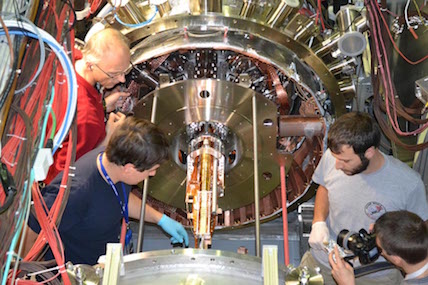The primary scientific goal of the Antihydrogen Experiment: Gravity, Interferometry, Spectroscopy (AEGIS) at CERN is the direct measurement of the Earth's gravitational acceleration, g, on antihydrogen. The AEGIS experiment is a collaboration of physicists from all over Europe. In the first phase of the experiment, we will use antiprotons from the Antiproton Decelerator, together with a pulse of laser-excited positronium atoms (obtained by shooting positrons onto a nano-structured target) to make a pulse of horizontally-travelling antihydrogen atoms. These atoms will pass through an instrument called a Moiré-deflectometer. A system of gratings in the deflectometer splits the antihydrogen beam into parallel rays, forming a periodic pattern. After passing through the deflectometer the antihydrogen will hit a position sensitive detector system (Gravity module) and annihilate.
The commitment of the Norwegian groups to the AEGIS collaboration will be the development, construction and commissioning of the position sensitive detector. Detecting and reconstructing individual anti-hydrogen impacts to a level of the 10 micrometers needed for the AEGIS experiment has never been done before and will present one of the main challenges of this project. During the project we will take part in the operation of the experiment and be active within data analysis. Furthermore, we will contribute to the theoretical analysis of the Rydberg state of anti-hydrogen, developing new simulations for anti-hydrogen annihilation, as well as contributing to the positronium production development.
Do you want to join AEGIS? It is possible for instance as a CERN technical student, Master student and PhD student at the Universities of Oslo and Bergen as well as the CERN PhD program. Typical Master and PhD topics are:
- Research and development of silicon detector systems to study anti-matter. The student helps develop novel sensors and electronics (ASICS) to be used in UHV and at Cryogenic temperatures (< 77 K). The student will study different detector technologies and collect and study new data from anti-proton testbeams. The student learn to develop knowledge about particle physics, sensor development (in collaboration with SINTEF), ASICS (in collaboration with IDEAS) and electronics, readout systems and programming (C++, Root). The student is expected to participate actively in the international AEGIS collaboration and gets the opportunity to spend time abroad (short or long) e.g. through the CERN summer school, training session and testbeam activities.
- Development of data analysis tools and anti-matter simulations. The student helps to read out new data from novel detectors studying in particular the annihilation of antimatter in silicon. In addition, the student will develop simluation tools for an improved understanding of the events. The student learn to develop knowledge about particle physics, detector development, programming (Root, C++), simulation tools (GEANT, FLUKA) and statistics. The student is expected to participate actively in the international AEGIS collaboration and gets the opportunity to spend time abroad (short or long) e.g. through the CERN summer school, training session and testbeam activities.
This project is funded by the Norwegian Research Council, University of Bergen and the Bergen Research Fundation
